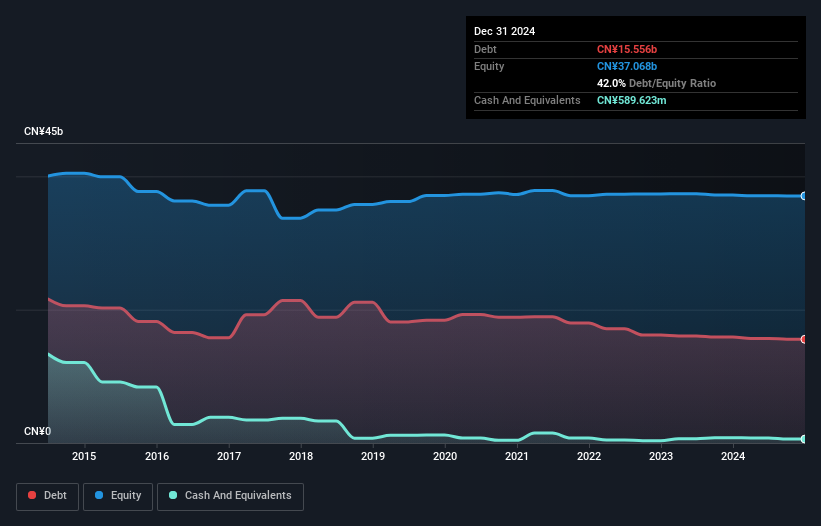- Hong Kong
- /
- Real Estate
- /
- SEHK:410
These 4 Measures Indicate That SOHO China (HKG:410) Is Using Debt In A Risky Way
Warren Buffett famously said, 'Volatility is far from synonymous with risk.' It's only natural to consider a company's balance sheet when you examine how risky it is, since debt is often involved when a business collapses. We can see that SOHO China Limited (HKG:410) does use debt in its business. But should shareholders be worried about its use of debt?
We've discovered 2 warning signs about SOHO China. View them for free.When Is Debt A Problem?
Debt assists a business until the business has trouble paying it off, either with new capital or with free cash flow. If things get really bad, the lenders can take control of the business. However, a more frequent (but still costly) occurrence is where a company must issue shares at bargain-basement prices, permanently diluting shareholders, just to shore up its balance sheet. By replacing dilution, though, debt can be an extremely good tool for businesses that need capital to invest in growth at high rates of return. When we examine debt levels, we first consider both cash and debt levels, together.
What Is SOHO China's Debt?
As you can see below, SOHO China had CN¥15.6b of debt, at December 2024, which is about the same as the year before. You can click the chart for greater detail. On the flip side, it has CN¥589.6m in cash leading to net debt of about CN¥15.0b.

How Healthy Is SOHO China's Balance Sheet?
According to the last reported balance sheet, SOHO China had liabilities of CN¥10.9b due within 12 months, and liabilities of CN¥20.1b due beyond 12 months. On the other hand, it had cash of CN¥589.6m and CN¥520.0m worth of receivables due within a year. So its liabilities total CN¥30.0b more than the combination of its cash and short-term receivables.
The deficiency here weighs heavily on the CN¥2.63b company itself, as if a child were struggling under the weight of an enormous back-pack full of books, his sports gear, and a trumpet. So we definitely think shareholders need to watch this one closely. After all, SOHO China would likely require a major re-capitalisation if it had to pay its creditors today.
Check out our latest analysis for SOHO China
We measure a company's debt load relative to its earnings power by looking at its net debt divided by its earnings before interest, tax, depreciation, and amortization (EBITDA) and by calculating how easily its earnings before interest and tax (EBIT) cover its interest expense (interest cover). Thus we consider debt relative to earnings both with and without depreciation and amortization expenses.
Weak interest cover of 1.3 times and a disturbingly high net debt to EBITDA ratio of 15.7 hit our confidence in SOHO China like a one-two punch to the gut. The debt burden here is substantial. More concerning, SOHO China saw its EBIT drop by 9.6% in the last twelve months. If it keeps going like that paying off its debt will be like running on a treadmill -- a lot of effort for not much advancement. The balance sheet is clearly the area to focus on when you are analysing debt. But you can't view debt in total isolation; since SOHO China will need earnings to service that debt. So when considering debt, it's definitely worth looking at the earnings trend. Click here for an interactive snapshot.
But our final consideration is also important, because a company cannot pay debt with paper profits; it needs cold hard cash. So we always check how much of that EBIT is translated into free cash flow. Looking at the most recent three years, SOHO China recorded free cash flow of 26% of its EBIT, which is weaker than we'd expect. That weak cash conversion makes it more difficult to handle indebtedness.
Our View
To be frank both SOHO China's interest cover and its track record of staying on top of its total liabilities make us rather uncomfortable with its debt levels. And furthermore, its EBIT growth rate also fails to instill confidence. Taking into account all the aforementioned factors, it looks like SOHO China has too much debt. While some investors love that sort of risky play, it's certainly not our cup of tea. When analysing debt levels, the balance sheet is the obvious place to start. But ultimately, every company can contain risks that exist outside of the balance sheet. To that end, you should be aware of the 2 warning signs we've spotted with SOHO China .
Of course, if you're the type of investor who prefers buying stocks without the burden of debt, then don't hesitate to discover our exclusive list of net cash growth stocks, today.
New: Manage All Your Stock Portfolios in One Place
We've created the ultimate portfolio companion for stock investors, and it's free.
• Connect an unlimited number of Portfolios and see your total in one currency
• Be alerted to new Warning Signs or Risks via email or mobile
• Track the Fair Value of your stocks
Have feedback on this article? Concerned about the content? Get in touch with us directly. Alternatively, email editorial-team (at) simplywallst.com.
This article by Simply Wall St is general in nature. We provide commentary based on historical data and analyst forecasts only using an unbiased methodology and our articles are not intended to be financial advice. It does not constitute a recommendation to buy or sell any stock, and does not take account of your objectives, or your financial situation. We aim to bring you long-term focused analysis driven by fundamental data. Note that our analysis may not factor in the latest price-sensitive company announcements or qualitative material. Simply Wall St has no position in any stocks mentioned.
About SEHK:410
SOHO China
Engages in real estate development, property leasing, and related management activities in the People’s Republic of China.
Slightly overvalued with very low risk.
Market Insights
Community Narratives



